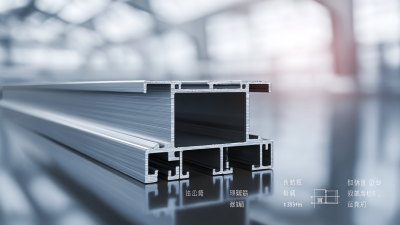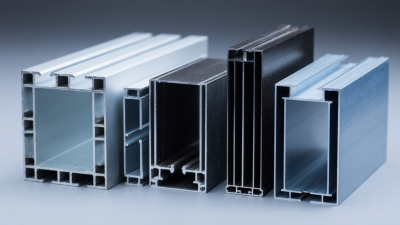In the realm of modern architecture, the innovation and adaptability of Building Aluminium Profiles have garnered significant attention. A recent industry report from the Aluminium Association highlights that the global aluminium market is projected to reach $250 billion by 2025, with architectural applications being a key growth driver.

As architects and builders increasingly prioritize sustainability and efficiency, Building Aluminium Profiles offer a unique solution, combining lightweight properties with exceptional strength and resistance to corrosion. Moreover, their versatility allows for a wide range of design applications, from framing to cladding, meeting aesthetic demands without compromising structural integrity.
With the increasing emphasis on energy efficiency in building design, the incorporation of these profiles can lead to reduced material usage and enhanced thermal performance, making them an essential component in contemporary construction practices.
Aluminium profiles have emerged as a cornerstone in contemporary building design, offering a combination of structural integrity, aesthetic appeal, and environmental sustainability. Their lightweight nature allows architects to explore bold designs without the burden of heavy materials, facilitating innovative structures that redefine modern architecture. The durability of aluminium means that these profiles not only withstand the elements but also require minimal maintenance over time, making them an economical choice for builders and homeowners alike.

Tips: When integrating aluminium profiles in your projects, consider using anodized finishes to enhance corrosion resistance and aesthetics. Additionally, incorporating natural elements like wooden textures in combination with aluminium can create a stunning visual impact, making your designs more appealing, especially in coastal environments. Emphasizing energy efficiency in designs, such as through well-placed skylights, can also elevate the functionality and ambiance of living spaces.
The versatility of aluminium profiles extends beyond aesthetics; they can be transformed into diverse applications, including windows, railings, and even intricate facade systems, all of which support innovative architectural trends. As sustainability becomes increasingly critical in construction practices, aluminium's recyclability positions it as a leading material in the future of architecture.
Aluminium profiles have become increasingly versatile in modern architecture, thanks to their unique properties such as light weight, high strength, and corrosion resistance. The innovative applications of aluminium profiles extend beyond traditional uses in construction. Recent reports predict that the aluminium extrusion market will experience significant growth, with an estimated market value of $44.7 million in 2025 and an expected compound annual growth rate of 4.4% through 2033. This shift reflects the material's growing relevance in high-value industrial applications, as well as in architectural structures.
Tips: When considering aluminium profiles for your architectural projects, keep in mind their sustainability benefits; they are fully recyclable, contributing to greener building practices. Additionally, modular construction techniques utilizing aluminium are gaining traction in the Middle East, showcasing the adaptability of these profiles in creating modern, efficient living spaces.
As the market evolves, collaborations between aluminium manufacturers and architectural firms are essential. Recent strategic partnerships, such as those involving significant players in the aluminium profile industry, highlight the movement towards more specialized and technologically advanced solutions tailored for contemporary architecture. Integrating these innovations can profoundly impact building design and construction efficiency.
The integration of aluminum profiles into modern architectural designs has gained traction due to their unmatched versatility and aesthetic appeal. According to the Aluminum Association, the use of aluminum in construction has increased by approximately 30% over the past decade, reflecting its growing importance across various architectural styles. This material allows architects to create sleek, contemporary facades that maintain structural integrity while embodying innovative design principles. Whether it’s in the form of window frames, cladding, or decorative elements, aluminum profiles enhance both functionality and style.
Different architectural movements, such as minimalism and industrial design, leverage the strengths of aluminum profiles to achieve distinct visual effects. For instance, in minimalist architecture, the clean lines and seamless integration of aluminum can contribute to a sense of openness and simplicity, which is essential to the style. Conversely, in industrial design, the use of raw aluminum showcases a rugged aesthetic that complements other materials like concrete and steel. A report from McKinsey indicates that the application of aluminum in construction not only improves energy efficiency but also reduces maintenance costs by up to 25%, making it a practical choice for sustainable architecture. This adaptability reinforces aluminum’s position as a pivotal element in modern design, suitable for a wide range of architectural themes.

The use of aluminium profiles in modern architecture offers significant sustainability benefits that align with contemporary construction practices. Aluminium is an abundant and recyclable material, which means that buildings constructed with aluminium profiles can be designed with end-of-life considerations in mind. This reduces the environmental impact, as aluminium can be recycled indefinitely without losing its properties, promoting a circular economy in the construction industry.
Furthermore, aluminium profiles contribute to energy efficiency in buildings. Their excellent thermal properties help in minimizing heat loss and gain, which leads to reduced energy consumption for heating and cooling. This is increasingly important in a world focused on lowering carbon footprints and achieving net-zero architecture. Additionally, the lightweight nature of aluminium profiles reduces the overall structural load, allowing for innovative design solutions that require less material and lower energy for transport and installation, thus enhancing the sustainability of building processes.
| Application Area | Benefits | Sustainability Characteristics | Recyclability | Cost Efficiency |
|---|---|---|---|---|
| Window Frames | Lightweight, Strong | High thermal efficiency | 100% recyclable | Long-term savings on energy bills |
| Structural Beams | Corrosion-resistant, Durable | Reduced carbon footprint over lifecycle | 100% recyclable | Cost-effective over long periods |
| Cladding Systems | Aesthetic appeal, Versatile designs | Improves building insulation | Easily recycled and repurposed | Lower maintenance costs |
| Roof Systems | Weather-resistant, Lightweight | Energy-efficient options available | Recyclable at end of life | Lower installation costs due to light weight |
| Furniture | Modern aesthetics, Customizable | Sustainable sourcing possible | 100% recyclable | Cost of production benefits from modern technology |
The use of aluminium profiles in modern architecture is evolving, reflecting advancements in design and construction techniques. As architects seek more sustainable and efficient materials, aluminium emerges as a prime choice due to its lightweight nature and strength. Future trends point towards innovative designs that leverage the flexibility of aluminium profiles, enabling the creation of complex, dynamic structures that were previously unattainable. This versatility not only accommodates aesthetic preferences but also fosters practical applications, such as energy-efficient facades and modular building systems.
Moreover, the integration of smart technologies with aluminium profiles will likely redefine architectural practices. With the increasing emphasis on sustainability, builders are turning to recyclable and energy-efficient materials. Aluminium's inherent recyclability aligns perfectly with these goals, paving the way for structures that are not only visually stunning but also environmentally responsible. Future developments may include enhanced thermal performance through innovative coatings and treatments that improve energy conservation, ensuring that aluminium profiles are not just functional but also pivotal in the transition towards sustainable architecture.






